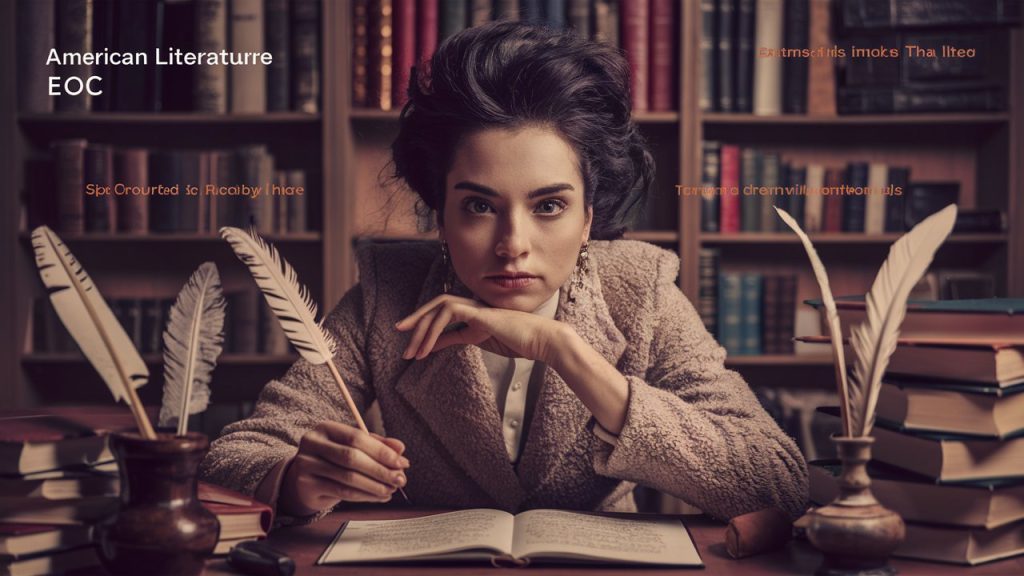Table of Contents
When studying American literature, understanding the American Lit EOC author’s style is critical to grasping the essence of various texts. The author’s style reflects their unique voice and shapes how readers interpret and connect with the narrative. This article will delve into the American Lit EOC author’s style, exploring different aspects contributing to compelling storytelling and how these techniques can enhance your appreciation and analysis of literature.
What Is the American Lit EOC Author’s Style?

The American Lit EOC author’s style refers to how authors use language and structure. This includes elements such as tone, diction, and narrative techniques that contribute to the overall feel of the text. Understanding these elements can help you analyze how authors craft their stories and convey their messages.
Critical Elements of an Author’s Style
To fully grasp the American Lit EOC author’s style, it’s essential to consider several key elements:
- Tone: The attitude or emotion that an author conveys through their writing. Tone can range from severe to humorous, affecting how the reader perceives the story.
- Diction: The choice of words an author uses. This covers the degree of formality as well as the word meanings.
- Syntax: The arrangement of words and sentences. Syntax can influence the flow of the text and how information is presented.
Analyzing Author’s Style in American Literature
Understanding the American Lit EOC author’s style involves analyzing how these elements create meaning and evoke emotions. Let’s look at how different styles are represented in American literature.
Narrative Voice and Perspective
Narrative voice and perspective are crucial aspects of the American Lit EOC author’s style. They determine who tells the story and from which point of view. Common perspectives include:
- First-Person: The story is told from the narrator’s viewpoint, using “I” or “we.” This perspective provides an intimate look into the narrator’s thoughts and experiences.
- Third-Person Limited: The narrator is outside the story but focuses on the thoughts and feelings of one character. This allows readers to connect deeply with that character’s experiences.
- Third-Degree Omniscient: Every detail about every character and incident is known to the storyteller. This viewpoint offers a deeper comprehension of the narrative and its characters.
Use of Symbolism and Imagery
Symbolism and imagery significantly influence the American Lit EOC author’s style. These elements add depth to the story by using symbols and descriptive language to convey themes and emotions.
- Symbolism: Authors use symbols to represent ideas or concepts beyond the literal meaning. For example, a river might symbolize the flow of life or change.
- Imagery: Descriptive language that appeals to the senses. Imagery helps readers visualize scenes and connect emotionally with the story.
Examples of American Lit EOC Author’s Style
Examining specific examples of the American Lit EOC author’s style can provide insight into how these techniques are applied in practice. Let’s explore a few notable authors and their styles.
Mark Twain’s Narrative Style
Mark Twain is known for his distinctive use of regional dialects and humor. His style often includes:
- Colloquial Language: Twain’s use of regional speech patterns adds authenticity and character to his dialogue.
- Satire: Twain employs satire to critique societal norms and issues, often using humor to highlight his points.
F. Scott Fitzgerald’s Lyrical Prose
F. Scott Fitzgerald is renowned for his lyrical and elegant prose. His style features:
- Rich Descriptions: Fitzgerald’s detailed descriptions create vivid imagery and set the mood for his narratives.
- Symbolism: His work often includes symbols that enhance themes, such as the green light in The Great Gatsby, which represents the American Dream.
How to Apply the American Lit EOC Author’s Style in Your Analysis

Analyzing the American Lit EOC author’s style involves applying these concepts to understand how they contribute to the narrative.
Close Reading Techniques
To analyze an author’s style effectively, practice close reading:
- Pay Attention to Word Choice: Notice how the author’s choice of words affects the tone and meaning.
- Analyze Sentence Structure: Observe how sentence length and structure influence the narrative flow.
Thematic Connections
Connect the author’s style to the themes of the text:
- Identify Themes: Look for recurring ideas and symbols in the text.
- Relate Style to Theme: Consider how the author’s style helps convey these themes and enhance the reader’s understanding.
Also read: 4 Leadership Styles That Will Empower You to Lead with Unstoppable Confidence
In sum up, the American Lit EOC author’s style is crucial to understanding and appreciating American literature. By analyzing elements such as tone, diction, and narrative perspective, you can uncover authors’ techniques to tell their stories effectively. Mastering the analysis of the American Lit EOC author’s style will enhance your reading experience and improve your ability to engage with and interpret various literary works. As you explore different styles, remember that each author brings a unique approach to storytelling,




